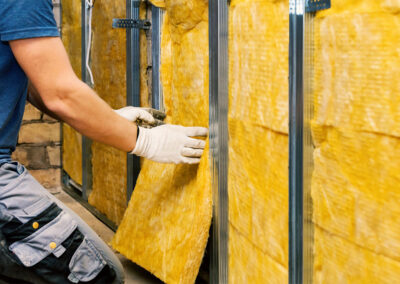We believe retrofit can play a huge part in lowering your energy costs, growing the economy and reducing emissions.
But what is retrofit? Why is it important? And how will this grow the economy whilst lowering costs? All these questions and more answered below.
What is Retrofit?
Retrofit is improvement work on existing buildings, such as your home, workplace or community facility, to improve energy efficiency and lower your bills.
Some common works that can be considered to be retrofit are:
- Insulating walls, roofs and floors;
- Upgrading windows and doors and installing external window shutters;
- Installing solar panels;
- Installing mechanical ventilation, trickle vents and extractor fans;
- Moving away from fossil fuels, such as by changing the heating source to an air source or ground source heat pump;
Examples of complementary measures include:
- Installing electric vehicle (EV) charging equipment;
- Smart controls, like smart meters, which could be used in conjunction with other technology like battery storage.
This list is not exhaustive, especially as innovative technologies are constantly being developed. Also, every building is different and requires a unique approach to ensure the right works are completed. For example, heritage buildings may require more bespoke measures.
Why is Retrofit important?
Retrofitting buildings can make them easier to heat and keep cool, lower bills and reduce greenhouse gas emissions, with benefits to health and wellbeing. Retrofit is also a £8.7 billion opportunity for our local supply chain. These benefits of retrofit are important because:
- As of 2023, there were approximately 50,000 households in fuel poverty in York and North Yorkshire. Additionally, cold homes have been found to have a direct negative impact on physical and mental health;
- As of 2024, 36.3% of households spend more than 10% of their income on domestic energy, an increase on previous years, and nine in ten businesses expect to increase the price of their goods and services as a result of high energy bills;
- Properties with an EPC rating below EPC E cost an average of £1000 more per year to heat than a typical home;
- Buildings are responsible for 25% of York and North Yorkshire’s emissions.
Will retrofitting damage our historic buildings?
With a bespoke approach, retrofit can be suitable for historic buildings making them more comfortable to live, work and visit. There are many innovative materials and technologies that can be used to navigate challenges specific to older buildings, such as insulation that looks like traditional brickwork. The approach should also take into account listed building status and whether the building is in a conservation area. This means we can continue to enjoy our heritage sites now and into the future.
What is the Retrofit Strategy?
York and North Yorkshire’s draft Retrofit Strategy is a collaborative document that sets out a long-term direction of travel for retrofit in York and North Yorkshire. Its aim is to provide a clear, co-owned plan to accelerate retrofit in York and North Yorkshire. It is intended to complement other work in the region, not replace it. It has been co-designed by regional and national partners, and has utilised previous work from key stakeholders in the region.
The Strategy includes action plans which detail projects and initiatives focused around six strategic priorities: Demand, Skills and Supply Chain, Finance Innovation, Data and Research, Stakeholder Collaboration, and Programmes and Demonstrators.
As a living document that will be refreshed in the future, the Strategy focuses on priorities and interventions between 2025 and 2030. This is because we are still awaiting key decisions at a national level which will impact the retrofit system, and new technologies and approaches are emerging every day.
Why does York and North Yorkshire need a Retrofit Strategy?
To make more retrofit happen at a greater pace and scale, we need a strategy for the region which considers the challenges and opportunities. This will help us when talking to central government about future funding and powers, help us plan out projects and services, and guide future policy that affects people in York and North Yorkshire. The Retrofit Strategy will also help bring together key stakeholders in retrofit, like skills providers, supply chain businesses, social housing providers etc.
What does the Retrofit Strategy mean for me?
The draft Retrofit Strategy sets out what we need to make retrofit easier, more affordable and more accessible, so everyone in York and North Yorkshire can feel the comfort, cost and climate benefits. Long term, this could be more programmes, services and support.
Why are we drafting the Retrofit Strategy now?
Now is an excellent time to draft our Retrofit Strategy, as Combined Authorities are being given more local powers and devolved funding to deliver retrofit. Therefore, it is essential that we map out our approach now to cement our strong position, so we can make the most of future opportunities.
Why did we consult you on this strategy?
We want to make sure that the Strategy is right for everyone in the region. We’ve done some extensive engagement with organisations like Local Authorities, national experts and skills providers, but we wanted to ensure we collected as many views as possible, including the general public.
What happens after the consultation?
Our consultation ended in December 2025, and the team will analyse the feedback and make any changes needed. The re-drafted Strategy will then be taken through the Combined Authority’s governance process in 2026.
How does this Strategy relate to other documents, like the Local Growth Plan?
This Strategy forms part of the ‘Clean Energy’ competitive advantage sector in the Growth Plan. The Retrofit Strategy is also a key part of the warm, comfortable buildings section of the Route-map to Carbon Negative.
The Strategy is intended to compliment, not replace, existing work such as North Yorkshire Council’s Climate Change Strategy and City of York Council’s Retrofit Action Plan.









